Companies that implement revenue operations (RevOps) shot up nearly 3 times faster—proving once again that it’s never a good idea to function as a lone wolf when it comes to scaling revenue.
In this guide, you’ll learn everything about RevOps, like how it differs from Sales Ops, the key metrics to track your unified strategy, and how you can align every money-making department with Breadcrumbs today.
Buckle up your seatbelt, and let’s get ready for a RevOps takeoff.
What Is Revenue Operations (RevOps)?
Revenue operations is a function where a business aligns its marketing operations, sales operations, and customer success operations to drive revenue growth through operational efficiency.

On top of improving operational efficiency across the revenue chain, revenue operations also drives revenue predictability and provides visibility across the entire revenue-focused teams.
What do Revenue Operations Managers Do?
RevOps is a hybrid role.
The title of these revenue operations managers vary due to organizational maturity.
When Breadcrumbs interviewed startup founders who’ve implemented revenue operations in their business, these titles popped up in our conversations:
- Head of RevOps
- Director of Revenue Cycle
- RevOps Manager
- VP of Growth
- Chief Revenue Officer (CRO)
Revenue operations is often led by a data-driven C-level executive with vast knowledge across different fields, including customer acquisition, revenue forecasting, and lead processing pipeline.
For example, Alana Zimmer, a director of revenue operations at Scalefast, specializes in optimizing data-led processes, systems, and tool stacks from the acquisition, retention, and every stage in between—right down to the granular level.
Similarly, Carol Martindale, a VP of global revenue operations at Leadfeeder, works closely with her go-to-market (GTM) and revenue teams to optimize processes and streamline information flow across departments.
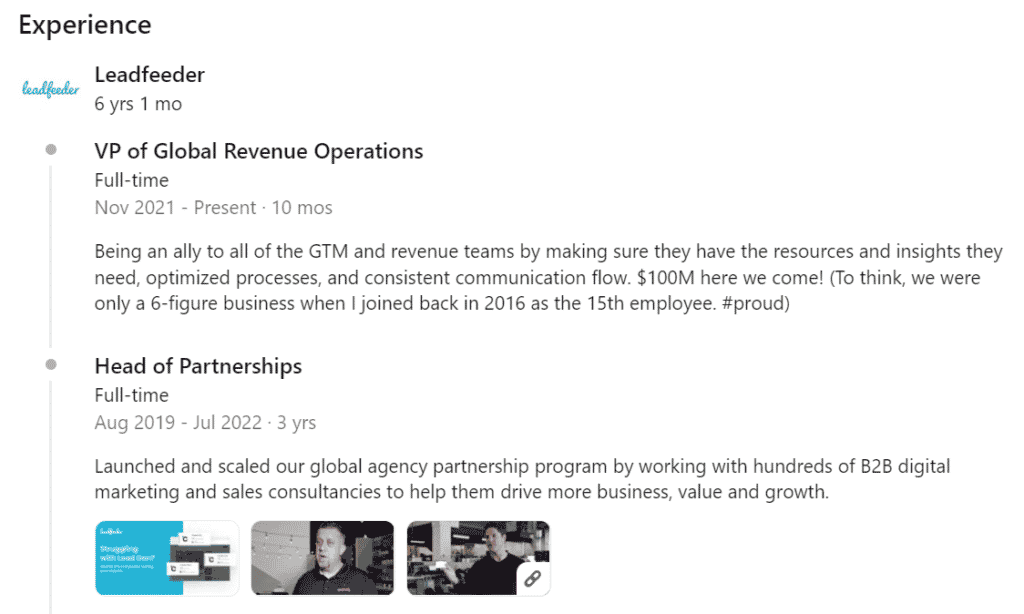
Both leaders boast an impressive track record in revenue-focused fields before going into RevOps.
Alana previously held senior roles in business operations, while Carol excelled in marketing, partnerships, and business development.
Why is Revenue Operations Important?
Revenue marketing was born out of necessity.
Back then, marketers, sales teams, and customer success reps would operate independently with their individual technology stack. This often results in silos, miscommunication, and time loss, putting a real damper on the company’s overall productivity and revenue growth.
Revenue operations solves this problem, as it aligns all revenue-driven departments deeply. Instead of operating in isolation, different departments rally together, set common goals, and share resources from a single place.
Revenue operations supports revenue marketing (a better way of thinking about it: RevOps is a natural evolution of revenue marketing).
-
What is a Marketing Qualified Lead (MQL)?
Read more: What is a Marketing Qualified Lead (MQL)?An MQL (or Marketing Qualified Lead) is a term used in marketing and sales to…
-
What is a Sales Qualified Lead (SQL)?
Read more: What is a Sales Qualified Lead (SQL)?A Sales Qualified Lead (SQL) is a prospective customer who has been researched and vetted…
-
What is a RevOps agency?
Read more: What is a RevOps agency?A RevOps agency, or Revenue Operations agency, is a specialized business entity that focuses on…
When Do You Need RevOps?
A bootstrapped startup recently founded a week ago doesn’t need RevOps.
But a mature startup that’s experiencing stagnant revenue growth? Now that’s a different story.
Here are five common signs you need to activate revenue operations in your startup, stat:
Sign 1. Your departments are clashing
You know trouble’s brewing when your employees from different departments approach you for clarification every. single. day.
Back then, sales employees at Force by Mojio kept receiving conflicting messages from the head of marketing and head of sales.
Daivat Dholakia, the former director of operations at the GPS vehicle tracking startup, reveals to Breadcrumbs:
“This sales employee came to me in confusion. Despite holding regular executive meetings to get everyone on the same page, there was a fundamental miscommunication on how we were advertising and selling our services.”
When a friend mentioned her RevOps team, Daivat decided to give it a try.
Sign 2. You want to improve marketing and sales efforts
According to 87% of sales and marketing leaders, sales and marketing alignment encourages critical business growth.

Review your revenue-driven departments to uncover hidden growth opportunities.
StorySlab is a field sales platform that took on a Series A funding during COVID-19 last year.
Hans Fuller, the founder and CEO, realized he and his team needed to optimize their time and resources strategically if they wanted to grow their footprint successfully, particularly in marketing and sales.
Hans explains, “If our SaaS platforms spoke to one another, it would give us a crystal clear picture of our sales process and where the growth opportunities were.”
Sign 3. You’re a technical founder without an established sales process
A company of one will have a different approach to selling than a fully staffed sales team.
Jason Cutter, CEO and founder of Cutter Consulting Group, shares with Breadcrumbs:
“This technical founder has built a company and most likely has client revenue coming in, but they’ve been the main producer of sales that’s usually based on their knowledge and passion, not a designed sales process.”
It’s only a matter of time these technical founders experience challenges at some point.
If you’ve recruited, trained, and managed sales reps; written a bunch of sales scripts; or invested in sales enablement software, and none of the approaches are showing results, then it could be a sign you need RevOps.
Sign 4. You want to scale, period!
The strategies that got you your first 10 customers are unlikely to work again as you scale.
For example, a one-on-one outreach on LinkedIn and ProductHunt might work when you were building an MVP. But as your product gains maturity and takes on a product-led growth (PLG) model, you’ll need different strategies (e.g., improve in-app onboarding).
“I’ve seen many organizations that have 50+ salespeople that don’t have the basic RevOps systems in place,” shares Jason.
“The CEO understands that if they try to grow, things could fall apart. What they’re looking for is a scalable, repeatable revenue ops machine—one that even if they add one, 10, or 50 sales professionals and $1-$100,000 marketing dollars, they can still get an expected output from the sales team.”
Sign 5. You want to create a superb customer experience
32% of customers will stop doing business with a brand they loved after just one bad experience. It’s no understatement, then: Customer experience plays one of the biggest roles in revenue growth.

RoverPass had only one employee handling marketing and customer support in the early days of business.
CEO Ravi Parikh was concerned if he started branching out his startup, he would “lose the ability to align our interest in delivering the best possible experience to customers across all our teams.”
So when he finally had the means to recruit more employees for his marketing team, he decided to implement revenue operations.
-
What Is B2B Retargeting and How Can It Generate More Leads?
Read more: What Is B2B Retargeting and How Can It Generate More Leads?Have you ever casually browsed a product online, only to suddenly see ads and promotions…
What’s the Difference Between RevOps and Sales Ops?
Both RevOps and Sales Ops play a unique role in revenue acceleration, and they are different in their approaches (one easy way to tell them apart is that Sales Ops is a subset of RevOps).
Sales operations supports and empowers sales teams to sell more efficiently. It’s not just setting quotas and hitting targets. Sales Ops also involves:
- Implementing sales incentives programs
- Enforcing processes and methodologies
- Optimizing sales platforms like CRMs and contract management tools
Revenue operations aligns marketing operations, sales operations, and customer success operations, centering around practices like demand management and upselling and renewals.
While there are overlaps in both functions (note: this is quite common in smaller startups, as again, it depends heavily on organizational maturity), bear in mind they are not interchangeable and should never replace one another.
What are the Key Metrics for Revenue Operations?
Your metrics will depend on the nature of your business.
For example, if you offer a flat-rate pricing plan like Basecamp, you can ignore irrelevant metrics like cross-sells and upsells.
Generally speaking, you can’t go wrong with the following metrics:
- Annual recurring revenue
- Cost of customer acquisition
- Customer lifetime value
- Forecast accuracy
- Renewals
- Customer churn
These metrics track the outcome of your unified revenue strategy.
For example, high customer churn could signal poor onboarding or customer service. In this case, the customer success and product team should work closely together.
How Can I Implement RevOps at My Company?
Revenue operations meshes multiple departments and unites every stakeholder to work towards a common goal. In general, it encompasses three main categories: people, tech stack, and processes.
1. Create sales enablement content (or audit and improve them)
Enterprise companies lose over $2.3 million every year due to opportunity costs associated with underused or unused sales enablement content. That’s a lot of money for just a year.
Sales enablement content is an internal asset that sales reps use in the selling process. This content is often used to address concerns and engage prospects. Common examples include:
- Sales scripts
- Objection handling guides (e.g., price objections)
- Email templates (e.g., request demo, follow up)
- Marketing materials
- Sales battlecards
- Demo and sales deck presentations
- Ideal customer profile (ICP)
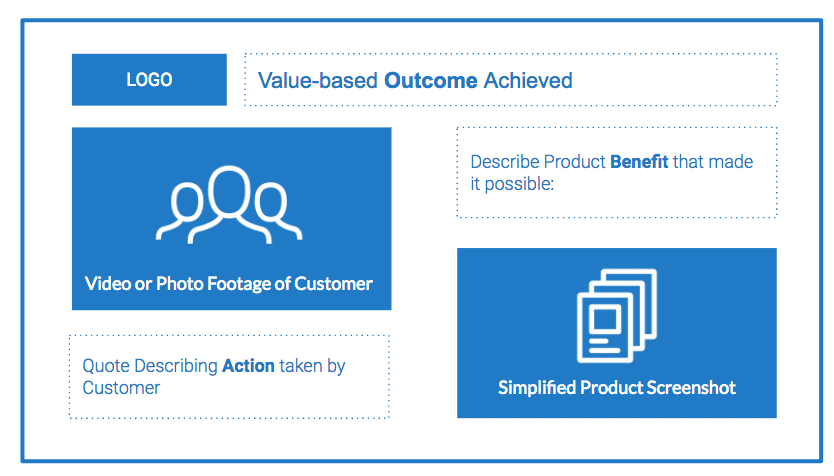
You don’t need to create this sales enablement content from scratch. Odds are, you probably have snippets of these content assets lying around in your communication channels (e.g., emails, and sales recordings on Zoom).
Here’s what you need to do: Recap on your most successful sales deals, focusing on those where leads immediately said yes or were convinced by you in the end.
While reviewing these deals, try to spot the phrases, pitches, or the like that you can reuse. Maybe it’s a first-meeting script that never fails to establish rapport with a prospect or a particular line in your email that overcomes a customer’s objection.
Document and reverse engineer everything you did to close these deals. Refine if necessary, and save it in a folder where your revenue operations team can access it easily.
2. Recruit and train your A-star sales team
80% of high-performing sales teams rate their sales training as very good or outstanding.
It certainly adds up.
When Jason worked with clients who needed help with revenue operations, he discovered that people with sales experience are often hired without being properly trained.
“Sales experience can be helpful, but unless they have experience selling the exact product to the exact demographic, they will need training, scripts, and leadership guidance.”
Jason Cutter, CEO and founder of Cutter Consulting Group
These are the main types of salespeople you’ll hire, according to Jason:
- Experienced or veteran sales professional
- New/inexperienced salesperson
- Entrepreneurial salesperson
“There are pros and cons for each type of salesperson, ways that each need to be managed and led, and different compensation requirements to consider,” adds the former RevOps consultant.
Consider these three factors when deciding which salesperson to hire, especially if this is the first time you’re building a new team:
(i) What’s the compensation available?
Naturally, hiring a veteran sales professional will cost more than a salesperson with two years of experience under their belt.
If you’re unable to offer a high salary, consider offering equity shares to attract top sales talent. Transparency in compensation is crucial when recruiting experienced professionals, so consider making a real pay stub daily to demonstrate your commitment to fair and competitive remuneration. Here’s a SaaS on-targets earning plan for reference:

(ii) How much time and energy am I (or the leadership team) willing to commit for training and mentoring?
It takes time to whip a sales team to shape.
CEOs or founders swamped with work priorities need to consider hiring a VP of sales or head of RevOps if they’re unable to get the team up to speed on their own.
(iii) Do they have comparable industry sales experiences?
Even the most experienced sales rep will need some level of guidance.
As the captain of the ship, the founder or CEO needs to get actively involved in sales training.
“When starting your first RevOps team, avoid assuming that if you hire experienced salespeople, you won’t have to deal with it or that you’ll be able to figure it out on your own. You need to get actively involved in training, mentoring, managing, and leading for probably longer than you’d hoped.”
Jason Cutter, CEO and founder of Cutter Consulting Group
Similarly, if you’re unable to invest time in training the sales team, consider hiring a C-level revenue executive.
3. Optimize cross-functional collaboration
Cross-functional collaboration, where people from different departments join forces to solve a common goal, plays a gigantic role in revenue operations.
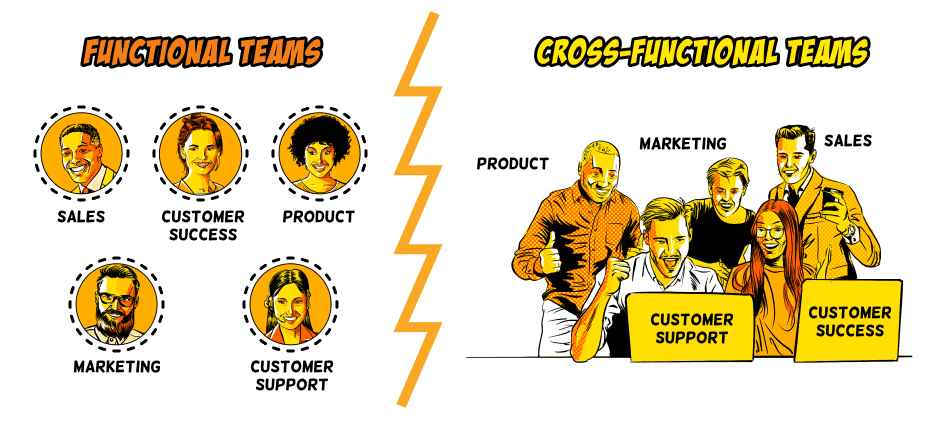
As you collaborate with these different departments, you’ll encounter challenges such as blurred lines of responsibilities, fear of conflict, competing priorities, trust issues, and missing context.
Here are five common examples of cross-functional collaboration challenges and how to overcome them with advice from startup founders.
Challenge #1: Misaligned goals and priorities across departments
Highly aligned companies outperformed their misaligned counterparts—to the point where they grew revenue 58% faster and are 72% more profitable.
With this statistic in mind, watch out for employees setting personal goals to meet the targets unique to their roles.
“When the focus shifts to prioritizing activities that help people achieve their personal goals, you might lose sight of the bigger picture,” warns Thilo Huellmann, CTO of Levity.
To avoid this problem, reward cross-functional project achievements.
Thilo adds, “Make it clear that pursuing cross-functional objectives does not distract from personal growth, but rather strengthens it.”
Consider getting the team leaders to meet separately and discuss how they can achieve the cross-functional team’s objectives.
Challenge #2: Unclear command structure
Conflicting messages from different department heads often result in confusion, time loss, and damaged productivity.
And that’s just the tip of the iceberg.
In the long run, this sloppy organizational structure hurt revenue.

Adam Garcia, founder of The Stock Dork, recommends a straightforward solution: Define the lead roles as early as possible.
“Create a clear hierarchy even before the teams are introduced to each other,” explains Adam.
“Nothing can undermine a project or team more efficiently than a faulty chain of command statement. Make a decision and put it in writing. It’s worth noting that this is often when egos come into action. If this hasn’t been fully discussed yet, it should be done as soon as possible.”
Challenge #3: Missing context
Explaining practical processes verbally leaves too much room for interpretation, especially when it involves different departments with little understanding of each other’s expertise.
In fact, SERPWizz founder, Deepak Shukla, believes that these verbal explanations are the root cause behind miscommunication.
“Teams should stop explaining problems and processes to each other and start showing them to each other instead.”
Deepak Shukla, founder of SERPWizz
Deepak’s experience brings to mind an article on Grow And Convert. In this piece, co-founder Benji Hyam writes, “Explaining what marketers do on a daily basis, to sales, helps bridge the gap between sales and marketing.”
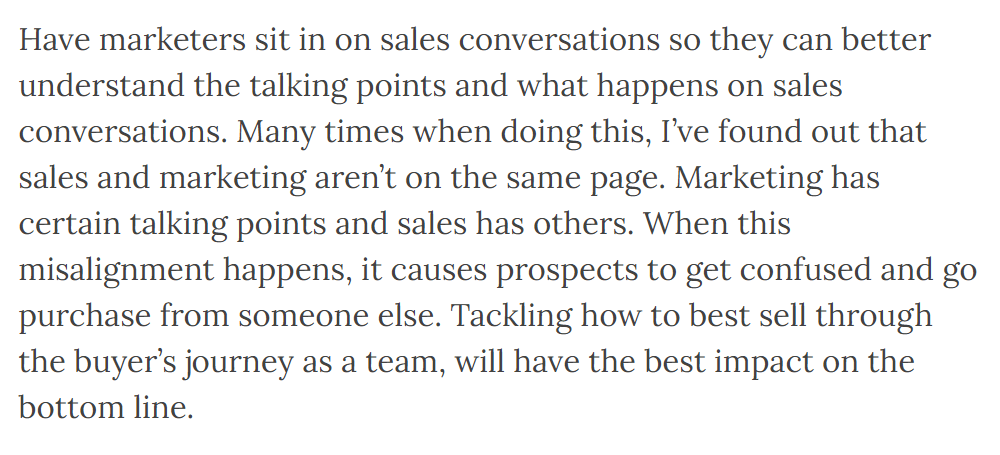
For example, sales reps could skip explaining client conversations to marketers. Invite them to listen to sales calls instead, so they can see for themselves what happens and create marketing materials with better context.
“Learning becomes more impactful when different teams understand how each other works in practice through the power of showing,” adds Deepak.
“Misunderstanding is reduced and teams become more accountable. This builds trust because each team can envision what the other is doing when they reference a task.”
Challenge #4: Lack of knowledge sharing
Poor knowledge-sharing practices cost Fortune 500 companies $31.5 billion annually.
Without accessible information, teams can’t perform efficiently. For example, marketers can’t create effective campaigns if they have zero clue of which ones drive the highest (or lowest) number of quality leads.
Ensure your cross-functional RevOps team can easily pool their diverse perspectives to address pressing issues.
“The cost of unwillingness to share knowledge is huge, and it can be a waste of your company’s valuable resources,” emphasizes Mike Dragan, COO of Streams.Live.
“Everyone should contribute their knowledge to the problem. After all, putting together a diverse group of people for RevOps is the whole idea.”
One way to streamline information flow is to use a PLG CRM.
PLG CRMs act as a single source of truth for revenue-facing teams: marketing, sales, product, and customer success.
To get started:
- Connect your product analytics platform with Breadcrumbs
- Determine what makes a product-qualified lead (PQL)
- Connect your CRM with Breadcrumbs
- Determine what makes a sales-qualified lead (SQL)
- Determine what makes a customer with cross- or upsell potential
- Set all scoring models live
Breadcrumbs will send all scoring information back to your CRM. Whenever leads or customers hit a point threshold (determined by you), your data source will notify you of the opportunity.
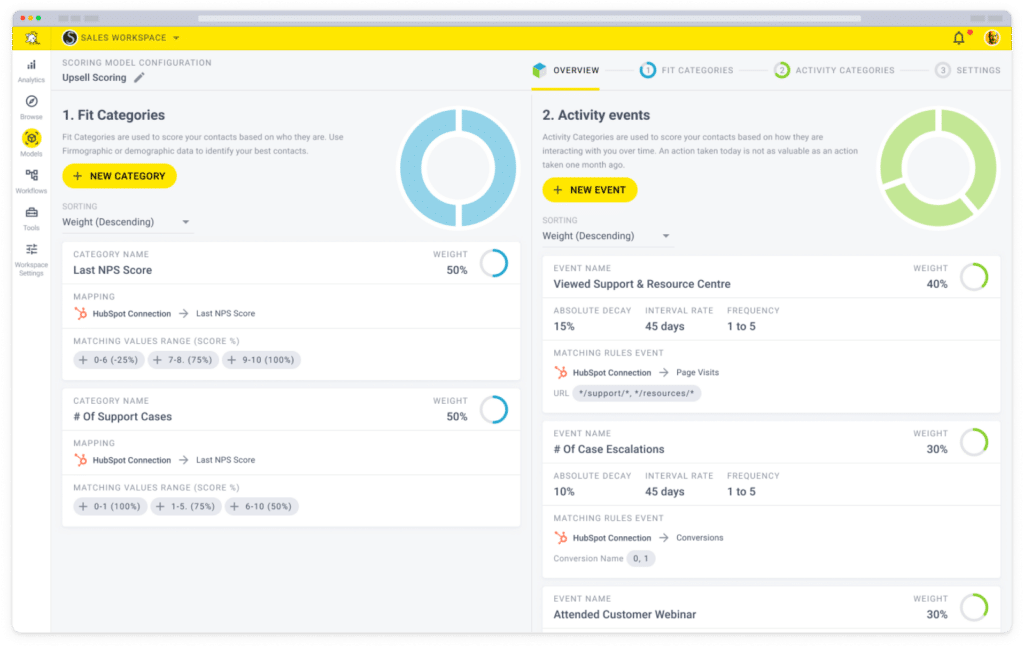
This central hub eliminates information silos.
For example, a customer success (CS) rep might receive a notification of a customer with upsell potential. Instead of pitching them a premium plan right away, the CS rep might review the past sales conversations, in-app activity, and the emails they’ve clicked on in the CRM and pitch accordingly.
Book a 30-minute demo with Breadcrumbs to align all revenue-focused departments today.
Challenge #5: Ineffective communication tools
Employee productivity increases by 20-25% when employees are connected.
It’s impossible to run your revenue operations when employees are unable to communicate with each other effectively. Spreadsheets can only do so much.
Here are the must-have communication tools every startup should have, according to Joseph Fung, CEO, and founder of UVARO:
(i) Instant messaging for quick-fire communication
What it’s for: Quick and in-the-moment conversations
Examples: Slack, Chanty, Microsoft Teams
(ii) Video for cross-functional projects and meetings
What it’s for: Visual presentations and high-stakes meetings
Examples: Zoom, Google Meet, GoToMeeting
(iii) Knowledge capture and sharing tools for complex cross-functional projects
What it’s for: Cross-functional projects where one can do both ‘at a glance’ information skimming and deep dives into specific tasks
Examples: Kiite, Trello, Asana, employee onboarding systems
UVARO uses Kiite’s Playbooks™ to share information on revenue operations activities and employee onboarding.
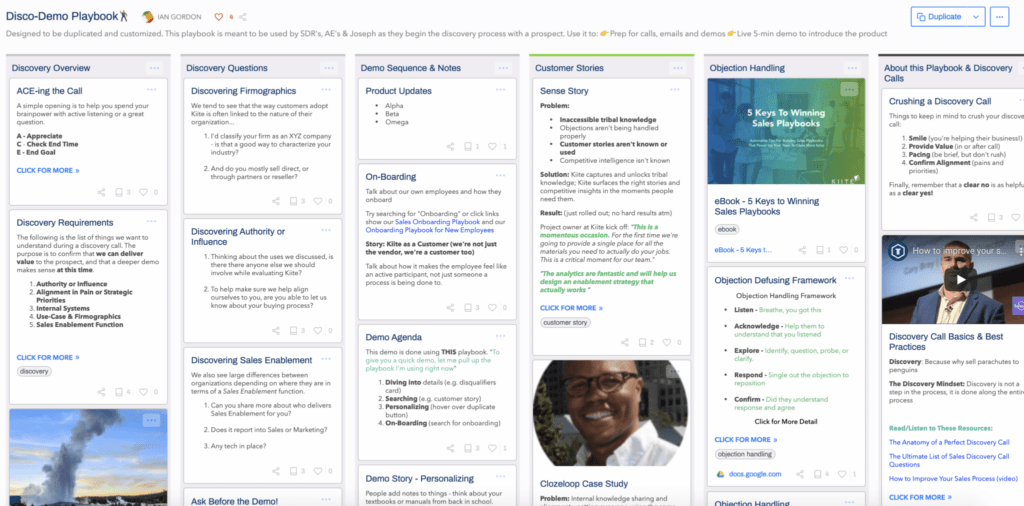
When evaluating knowledge-sharing platforms, prioritize these additional features:
(a) Debriefs and report
Debriefs and reports (such as sales dashboards) are often overlooked, especially by startups that run fast towards their goals.
“There’s a lot of experimentation at this stage,” shares Joseph.
“Making debriefs and reporting a part of your business culture right from the beginning will pay off in the long run because it will give you increased visibility into similar future projects that are critical to your business.”
Don’t skip this feature. It’ll help speed up your planning for related projects in the future.
(b) Broadcast activities
Knowledge-sharing tools should keep every stakeholder in the loop.
Whether it’s moving a card from planning to in-progress or tagging the product team, broadcasting these activities foster trust and accountability.
(c) Prep and follow up
Revenue operations involves complex activities that require efficient follow-ups. Ideally, your knowledge sharing platform should make your communication productive and seamless.
“Any pre-read documentation should be concise and easily digestible,” advises Joseph.
“Any follow-up actions should be assigned either as a last part of the cross-functional meeting or directly afterward while things are fresh for all teams. Following this work cadence in a centralized tool goes a long way.”
Above all else, be intentional about your policies and processes reflecting your startup values.
“Often with the pressure of quarterly revenue targets, culture takes a back seat and is regarded as one of those ‘nice to haves’ when starting a business. At UVARO, we believe the relationship between KPIs and corporate culture is integrally related.”
Build this tactical alignment at a functional level in your company, and you’ll end up living your company’s values every day.
Create Your RevOps Strategy—Starting with Breadcrumbs Today
Revenue operations acts as a bridge between your marketing operations, sales operations, customer success operations—and in most cases, your product operations.
It connects the dots between these revenue-facing departments into one holistic view and gets everyone on the same page. Instead of working independently and keeping information to themselves, everyone collaborates towards a common goal, and knowledge is shared freely.
Use a PLG CRM to streamline information flow between departments. This single source of truth gives you a complete view of the customer journey, from the second they sign up for your email list to the confetti-moment they upgrade to an enterprise plan—and everything in between.
Book a 30-minute demo with Breadcrumbs to align all revenue-focused departments and accelerate revenue today.



